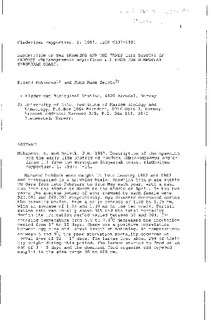| dc.contributor.author | Moksness, Erlend | |
| dc.contributor.author | Selvik, John Rune | |
| dc.date.accessioned | 2008-08-07T13:49:30Z | |
| dc.date.issued | 1987 | |
| dc.identifier.issn | 0333-2594 | |
| dc.identifier.uri | http://hdl.handle.net/11250/115076 | |
| dc.description.abstract | Matured haddock were caught in late January 1982 and 1983
and transferred to a spawning basin. Spawning took place within
90 days from late February to late May each year, with a maximum
from the middle of March to the middle of April. In the two
years the average number of eggs spawned by each female were
520.000 and 568.000 respectively. Egg diameter decreased during
the spawning period, from a daily average of 1.50 to 1.29 mm,
with an average of 1.38 and 1.39 mm in the two years. Fertilization
rate was usually above 80% and the total mortality
during the incubation period varied between 30 and 70%. Increasing
temperature from 5.5 to 7.0 degrees C decreased the incubation
period from 17 to 12 days. There was a positive correlation
between egg size and larval length at hatching. At temperatures
between 5 and 9 degrees C the peak starvation mortality occurred at
larval ages of 22 - 17 days. The larvae lost about 25% of their
dry weight during this period . The larvae started to feed at an
age of 3 - 5 days and the dominant food organism was copepod
nauplii in the size range 90 to 400 mm. | en |
| dc.format.extent | 466859 bytes | |
| dc.format.mimetype | application/pdf | |
| dc.language.iso | eng | en |
| dc.publisher | Havforskningsinstituttet | en |
| dc.relation.ispartofseries | Flødevigen rapportserie | en |
| dc.relation.ispartofseries | 1, 1987 | en |
| dc.title | Description of the spawning and the early life history of haddock (Melanogrammus aeglefinus L.) from the Norwegian Skagerrak coast. In: Flødevigen rapportserie no 1, 1987 | en |
| dc.type | Research report | en |
| dc.source.pagenumber | 1-16 | en |
